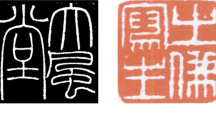Abstract
Recognizing characters in Chinese seal images is important when researching ancient cultural artworks because the seals may contain critical historical information. However, owing to large intraclass variance and a limited number of training samples, recognizing such characters in Chinese seals is challenging. Thus, this study proposes a graph-matching-based method to recognize characters in historical Chinese seal images. In the proposed method, a Chinese seal character is first modeled as a graph representing its underlying geometric structure. Then, two affinity matrices that measure the similarity of nodes and edge pairs are calculated with their local features. Finally, a correspondence matrix is calculated using a graph matching algorithm and the most similar reference is selected as the recognition result. Compared with several existing classification methods for seal image recognition, the proposed graph-matching-based method achieves better results, particularly in the case of limited samples.
Similar content being viewed by others
References
Roy P P, Pal U, Lladós J. Document seal detection using GHT and character proximity graphs. Pattern Recogn, 2011, 44: 1282–1295
Ren C, Liu D, Chen Y B. A new method on the segmentation and recognition of Chinese characters for automatic Chinese seal imprint retrieval. In: Proceedings of International Conference on Document Analysis and Recognition, 2011. 972–976
Roy P P, Pal U, Lladós J. Seal detection and recognition: an approach for document indexing. In: Proceedings of International Conference on Document Analysis and Recognition, 2009. 101–105
Yin F, Wang Q F, Zhang X Y, et al. Chinese handwriting recognition competition. In: Proceedings of International Conference on Document Analysis and Recognition, 2013. 1464–1469
Wang C H, Xiao B H, Dai R W. Parallel compact integration in handwritten Chinese character recognition. Sci China Ser F-Inf Sci, 2004, 47: 89–96
Guo J, Wang C H, Roman-Rangel E, et al. Building hierarchical representations for Oracle character and sketch recognition. IEEE Trans Image Process, 2016, 25: 104–118
Sebastian T B, Klein P N, Kimia B B. Recognition of shapes by editing their shock graphs. In: Proceedings of IEEE International Conference on Computer Vision, 2011. 755–762
Bai X, Latecki L J. Path similarity skeleton graph matching. IEEE Trans Pattern Anal Mach Intell, 2008, 30: 1282–1292
Zhang H, Mu Y, You Y H, et al. Multi-scale sparse feature point correspondence by graph cuts. Sci China Inf Sci, 2010, 53: 1224–1232
Zhang L M, Yang Y, Wang M, et al. Detecting densely distributed graph patterns for fine-grained image categorization. IEEE Trans Image Process, 2016, 25: 553–565
Mian A S, Bennamoun M, Owens R. Three-dimensional model-based object recognition and segmentation in cluttered scenes. IEEE Trans Pattern Anal Mach Intell, 2006, 28: 1584–1601
Jiang H, Yu S X, Martin D R. Linear scale and rotation invariant matching. IEEE Trans Pattern Anal Mach Intell, 2011, 33: 1339–1355
Zhao R, Martinez A M. Labeled graph kernel for behavior analysis. IEEE Trans Pattern Anal Mach Intell, 2016, 38: 1640–1650
Aksoy E E, Abramov A, Worgotter F, et al. Categorizing object-action relations from semantic scene graphs. In: Proceedings of IEEE International Conference on Robotics and Automation, 2010. 398–405
Belongie S, Malik J. Matching with shape contexts. In: Proceedings Workshop on Content-based Access of Image and Video Libraries, 2000
Liu C L, Kim I J, Kim J H. Model-based stroke extraction and matching for handwritten Chinese character recognition. Pattern Recogn, 2001, 34: 2339–2352
Fischler M A, Bolles R C. Random sample consensus: a paradigm for model fitting with applications to image analysis and automated cartography. Read Comput Vision, 1987, 24: 726–740
Schenker P S. Method for registration of 3-D shapes. IEEE Trans Pattern Anal Mach Intell, 2002, 14: 239–256
Cho M, Lee J, Lee K M. Reweighted random walks for graph matching. In: Proceedings European Conference on Computer Vision, 2010. 492–505
Mateus D, Horaud R, Knossow D, et al. Articulated shape matching using Laplacian eigenfunctions and unsupervised point registration. In: Proceedings IEEE Conference on Computer Vision and Pattern Recognition, 2008
Zhou F, De la Torre F. Factorized graph matching. IEEE Trans Pattern Anal Mach Intell, 2016, 38: 1774–1789
Otsu N. A threshold selection method from gray-level histograms. IEEE Trans Syst Man Cybern, 1979, 9: 62–66
Wang Y, Zhong B J. A scale-space technique for polygonal approximation of planar curves. In: Proceedings of IEEE International Conference on Image Processing, 2013. 517–520
Fukushima M. A modified Frank-Wolfe algorithm for solving the traffic assignment problem. Transpation Res Part B-Meth, 1984, 18: 169–177
Chang C C, Lin C J. LIBSVM: a library for support vector machines. ACM Trans Intell Syst Technol, 2011, 2: 1–27
Lecun Y, Bottou L, Bengio Y, et al. Gradient-based learning applied to document recognition. Proc IEEE, 1998, 86: 2278–2324
You C, Robinson D P, Vidal R. Scalable sparse subspace clustering by orthogonal matching pursuit. In: Proceedings of IEEE Conference on Computer Vision and Pattern Recognition, 2016. 3918–3927
Qu X W, Wang W Q, Lu K. In-air handwritten Chinese character recognition using discriminative projection based on locality-sensitive sparse representation. In: Proceedings of International Conference on Pattern Recognition, 2017. 1137–1140
Cao J L, Pang Y W, Li X L, et al. Randomly translational activation inspired by the input distributions of ReLU. Neurocomputing, 2018, 275: 859–868
Acknowledgements
This work was supported by National Natural Science Foundation of China (Grant Nos. 6152010-6001, 61801178), Natural Science Foundation of Hunan Province (Grant No. 2018JJ3071), and by Hunan Key Laboratory of Visual Perception and Artificial Intelligence.
Author information
Authors and Affiliations
Corresponding author
Rights and permissions
About this article
Cite this article
Sun, B., Hua, S., Li, S. et al. Graph-matching-based character recognition for Chinese seal images. Sci. China Inf. Sci. 62, 192102 (2019). https://doi.org/10.1007/s11432-018-9724-7
Received:
Accepted:
Published:
DOI: https://doi.org/10.1007/s11432-018-9724-7




